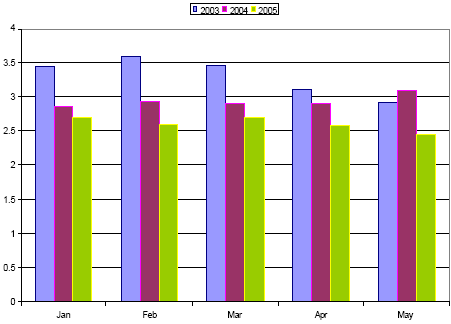



International Egg and Poultry Review
By the USDA's Agricultural Marketing Service - This is a weekly report looking at international developments concerning the poultry industry, this week looking at poultry production in Brazil.
Brazil
Broiler production in Brazil is estimated to reach 8.8 million metric tons
in 2005, up 5 percent from the record production level of 8.5 million
metric tons in 2004. Domestic consumption accounted for 6.1 million
tons, and 2.4 million metric tons were exported. In 2005 exports are
projected to increase 5 percent. Exports grew 26 percent in 2004, in
part due to the avian influenza outbreak in Asian countries.
The major production areas are the states of Rio Grande do Sul, Santa
Catarina, Parana, Sao Paulo, Minas Gerais, Goias, Mato Grosso and
Mato Grosso do Sul. On August 20, 2003 the Ministry of Agriculture
officially declared these states as free of Newcastle disease. These
states account for over 80 percent of poultry production and for the
entire poultry production destined for exports.
Major constraints for exports are the strong Real and higher domestic
interest rates combined with higher production costs. The Brazilian
Real rose in value in 2004 and 2005, compared to the US Dollar.

In 2002 the EU published EC No 1223/2002, reclassifying frozen boneless chicken cuts with a salt content of 1.2 percent or more as frozen chicken (0207) subject to a special safeguard duty of 102.4 euro per 100 kg net weight, compared to an ad valorem rate of 15.4 percent for salted meat (0210). In October, 2002 Brazil requested WTO consultations on EC No. 1223/2002. Through a joint letter dated June 17, 2004, Brazil and Thailand requested the WTO Director General determine the composition of the Panel. On May 30, 2005 the WTO published its Report of the Panel, concluding frozen boneless chicken cuts with a salt content of 1.2 percent to 3 percent are covered under the heading 02.10 and that the EU acted inconsistently when it reclassified 1.2 percent to 1.9 percent salted chicken meat from 0210 to 0207. The EU intends to file an appeal.
On May 30, 2005, Iagro (State Agency for Animal and Plant Health Protection) announced it had culled 17,000 birds the previous weekend after 6,000 birds died from an undiagnosed respiratory disease in Mato Grosso du Sul. In 2004 about 117.3 million chickens were produced in the State.
The farm and 107 neighboring properties were quarantined, roadblocks were set up on the three access roads to the property, and disinfectants were spayed on passing cars and trucks. Samples from the poultry were sent to MAPA (Ministry of Agriculture, Fisheries and Food) in Campinas, Sao Paulo.
Infectious bronchitis was suspected after test results ruled out avian influenza and Newcastle disease. Infectious bronchitis is classified as a List B disease by the OIE. The incubation period is one to two days and mortality may be as high at 25 percent in young chicks. Adults usually recover after a few weeks.
Source: OIE, ProMed-mail: Undiagnosed Disease, Poultry - Brazil, Official Journal of the European Communities, WTO, USDA/FAS, Brazil's Ministry of Agriculture, news wires
To view the full report, including tables please click here
Source: USDA's Agricultural Marketing Service - 7th June 2005








